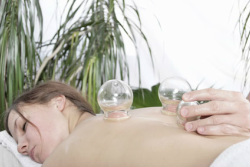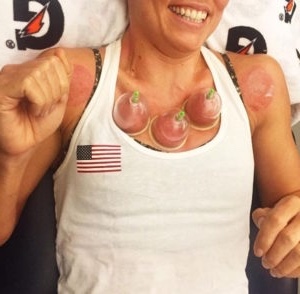Cupping is one of the oldest methods of traditional Chinese medicine. The earliest recorded use of cupping dates to the early fourth century, when the noted herbalist Ge Hong wrote about a form of cupping in A Handbook of Prescriptions. Later books written during the Tang and Qing dynasties described cupping in great detail; one textbook included an entire chapter on “fire jar qi,” a type of cupping that could alleviate headaches, dizziness and abdominal pain.
 There is reason to believe the practice dates from as early as 3000 BC. The Ebers Papyrus, written c. 1550 BC and one of the oldest medical textbooks in the Western world, describes the Egyptians’ use of cupping, while mentioning similar practices employed by Saharan peoples. In ancient Greece, Hippocrates (c. 400 BC) used cupping for internal disease and structural problems. The method was highly recommended by Prophet Muhammed and hence well-practiced by Muslim scientists who elaborated and developed the method further. Consecutively, this method in its multiple forms spread into medicine throughout Asian and European civilizations. In China, the earliest use of cupping that is recorded is from the famous Taoist alchemist and herbalist, Ge Hong (281–341 A.D.) Cupping was also mentioned in Maimonides’ book on health and was used within the Eastern European Jewish community. There is a description of cupping in George Orwell’s essay “How the Poor Die”, where he was surprised to find it practiced in a Paris hospital.
There is reason to believe the practice dates from as early as 3000 BC. The Ebers Papyrus, written c. 1550 BC and one of the oldest medical textbooks in the Western world, describes the Egyptians’ use of cupping, while mentioning similar practices employed by Saharan peoples. In ancient Greece, Hippocrates (c. 400 BC) used cupping for internal disease and structural problems. The method was highly recommended by Prophet Muhammed and hence well-practiced by Muslim scientists who elaborated and developed the method further. Consecutively, this method in its multiple forms spread into medicine throughout Asian and European civilizations. In China, the earliest use of cupping that is recorded is from the famous Taoist alchemist and herbalist, Ge Hong (281–341 A.D.) Cupping was also mentioned in Maimonides’ book on health and was used within the Eastern European Jewish community. There is a description of cupping in George Orwell’s essay “How the Poor Die”, where he was surprised to find it practiced in a Paris hospital.
Originally, practitioners would use hollowed-out animal horns for cups, and place them over particular points or meridians. Today, most acupuncturists use cups made of thick glass or plastic, although bamboo, iron and pottery cups are still used in other countries. Glass cups are the preferred method of delivery, because they do not break as easily as pottery or deteriorate like bamboo, and they allow the acupuncturist to see the skin and evaluate the effects of treatment.
How does cupping work? What does it treat?
In a typical cupping session, glass cups are warmed using a cotton ball or other flammable substance, which is soaked in alcohol, let, then placed inside the cup. Burning a substance inside the cup removes all the oxygen, which creates a vacuum.
As the substance burns, the cup is turned upside-down so that the practitioner can place the cup over a specific area. The vacuum created by the lack of oxygen anchors the cup to the skin and pulls it upward on the inside of the glass as the air inside the jar cools. Drawing up the skin is believed to open up the skin’s pores, which helps to stimulate the flow of blood, balances and realigns the flow of qi, breaks up obstructions, and creates an avenue for toxins to be drawn out of the body.
Depending on the condition being treated, the cups will be left in place from 5 to 10 minutes. Several cups may be placed on a patient’s body at the same time. Some practitioners will also apply small amounts of medicated oils or herbal oils to the skin just before the cupping procedure, which lets them move the cups up and down particular acupoints or meridians after they have been applied.
In China, cupping is used primarily to treat respiratory conditions such as bronchitis, asthma, and congestion; arthritis; gastrointestinal disorders; and certain types of pain. Some practitioners also use cupping to treat depression and reduce swelling. Fleshy sites on the body, such as the back and stomach (and, to a lesser extent, the arms and legs), are the preferred sites for treatment.
How many types of cupping are there?
 In addition to the traditional form of cupping described above, which is known as “dry” cupping, some practitioners also use what is called “wet” or “air” cupping.
In addition to the traditional form of cupping described above, which is known as “dry” cupping, some practitioners also use what is called “wet” or “air” cupping.
In “air” cupping, instead of using a flame to heat the cup, the cup is applied to the skin, and a suction pump is attached to the rounded end of the jar. The pump is then used to create the vacuum. In “wet” cupping, the skin is punctured before treatment. When the cup is applied and the skin is drawn up, a small amount of blood may flow from the puncture site, which are believed to help remove harmful substances and toxins from the body.
Another similar modality is Gua Sha (otherwise known as “Graston Technique”), where the muscles are massaged with oil with a tool resembling a Chinese soup spoon.
Is cupping safe? Does it hurt?
While cupping is considered relatively safe (especially air cupping, which does not include the risk of fire and heat), it can cause some swelling and bruising on the skin. As the skin under a cup is drawn up, the blood vessels at the surface of the skin expand. This may result in small, circular bruises on the areas where the cups were applied. These bruises are usually painless, however, and disappear within a few days of treatment.
In addition, there are several instances where cupping should not be performed. Patients with inflamed skin; cases of high fever or convulsions; and patients who bleed easily, are not suitable candidates for cupping. Pregnant women should not have cupping on their stomach or lower back. If the cups are being moved, they should not cross bony areas, such as the ridges of the spine or the shoulder blades.
I would like to learn more about cupping. Where can I find out more information?
Several articles on cupping have been published in peer-reviewed journals and acupuncture websites. To learn more about cupping, you are encouraged to visit the following sites and read the following articles: •Cupping Therapy
